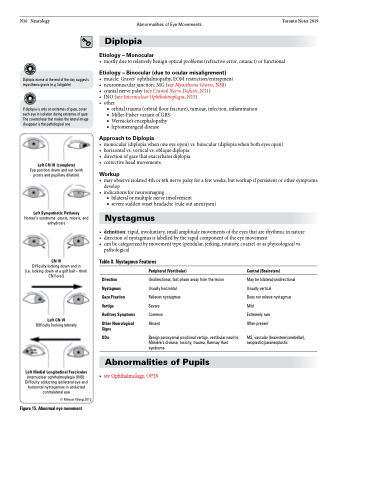Page 758 - TNFlipTest
P. 758
N16 Neurology
Diplopia worse at the end of the day suggests myasthenia gravis (e.g. fatigable)
If diplopia is only on extremes of gaze, cover each eye in isolation during extremes of gaze The covered eye that makes the lateral image disappear is the pathological one
Left CN III (complete)
Eye position down and out (with ptosis and pupillary dilation)
Left Sympathetic Pathway
Horner’s syndrome: ptosis, miosis, and anhydrosis
CN IV
Difficulty looking down and in (i.e. looking down at a golf ball – think CN Fore!)
Left CN VI
Difficulty looking laterally
Left Medial Longitudinal Fasciculus
Internuclear ophthalmoplegia (INO): Difficulty adducting ipsilateral eye and horizontal nystagamus in abducted contralateral eye
© Minyan Wang 2012
Figure 15. Abnormal eye movement
Abnormalities of Eye Movements Toronto Notes 2019 Diplopia
Etiology – Monocular
• mostlyduetorelativelybenignopticalproblems(refractiveerror,cataract)orfunctional
Etiology – Binocular (due to ocular misalignment)
• muscle:Graves’ophthalmopathy,EOMrestriction/entrapment • neuromuscularjunction:MG(seeMyastheniaGravis,N38)
• cranialnervepalsy(seeCranialNerveDeficits,N11)
• INO(seeInternuclearOphthalmoplegia,N15)
• other
■ orbital trauma (orbital floor fracture), tumour, infection, inflammation ■ Miller-Fisher variant of GBS
■ Wernicke’s encephalopathy
■ leptomeningeal disease
Approach to Diplopia
• monocular(diplopiawhenoneeyeopen)vs.binocular(diplopiawhenbotheyesopen) • horizontalvs.verticalvs.obliquediplopia
• directionofgazethatexacerbatesdiplopia
• correctiveheadmovements
Workup
• mayobserveisolated4thor6thnervepalsyforafewweeks,butworkupifpersistentorothersymptoms develop
• indicationsforneuroimaging
■ bilateral or multiple nerve involvement
■ severe sudden onset headache (rule out aneurysm)
Nystagmus
• definition:rapid,involuntary,smallamplitudemovementsoftheeyesthatarerhythmicinnature
• directionofnystagmusislabelledbytherapidcomponentoftheeyemovement
• canbecategorizedbymovementtype(pendular,jerking,rotatory,coarse)orasphysiologicalvs.
pathological
Table 8. Nystagmus Features
Direction
Nystagmus
Gaze Fixation
Vertigo
Auditory Symptoms
Other Neurological Signs
DDx
Peripheral (Vestibular)
Unidirectional, fast phase away from the lesion Usually horizontal
Relieves nystagmus
Severe
Common Absent
Benign paroxysmal positional vertigo, vestibular neuritis, Ménière’s disease, toxicity, trauma, Ramsay Hunt syndrome
Central (Brainstem)
May be bilateral/unidirectional Usually vertical
Does not relieve nystagmus Mild
Extremely rare Often present
MS, vascular (brainstem/cerebellar), neoplastic/paraneoplastic
Abnormalities of Pupils
• seeOphthalmology,OP28


